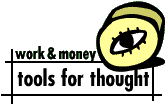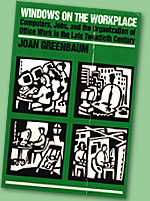
Title: Windows on the Workplace:
Computers, Jobs and the Organization of Office
Work in the Late Twentieth Century
Author: Joan Greenbaum
Year: 1995
Publisher: Cornerstone Books/Monthly Review Press
Price: $13.00 US
Review by: Harry Goldstein



Title: Windows on the Workplace:
|

 |
A former computer programmer and systems analyst, Joan Greenbaum knows all about efficiency in the workplace and what it means for the average office worker. Now a professor of computer information systems at LaGuardia Community College in New York City, Greenbaum is a scholar trying to pin down the perpetually shifting terrain that is the post-modern office. She traces how office work was organized in each decade from the 1950s onward, revealing that in each succeeding era it is the laws of efficiency as dictated by managers obsessed with the bottom line -- and not technology itself -- that has resulted in the computerized, virtually virtual workplace of today.

"The late twentieth century was to be the age of white-collar work -- of jobs that were dependable, well-paid, clean, and in nice workplaces. But the age of large, centralized offices, with traditional, well-defined jobs, is going to be far shorter than the industrial era that preceded it. More and more office jobs are being spread out over time and space, as the work is done at all times of the night and day by part-time and temporary workers."
(p. 19)"For many people, the slowing down and restructuring of office work means less stability and security. Government and business reports tell us that we can expect to switch jobs and careers at least five times in our working lives. But this is the longer economic view. In everyday life it means that people already employed need to keep an eye out for the next job, while those trying to win a toehold in the office world need to compete with a growing number of people, many of whom have more skills."
(p. 142)

A book by a professor of infotech systems that puts forth an historical, political-economic analysis of the modern office sounds like a book confined to an elite readership, a couple of eggheads in a university library somewhere in Berkeley or Cambridge. But "Windows on the Workplace" defies the conventions of most books by scholars -- it is short, devoid of scholarly jargon, and filled with anecdotes from people out in the real working world who are struggling with the office systems engineering and management techniques that Greenbaum cogently analyzes for us.This is a book written to give anyone the critical tools necessary to understand their position in the office organization, how they got there, and where they might be going. By providing a historical perspective on how offices developed into what they are today, Greenbaum's "Windows on the Workplace" helps us prepare for the next evolution in workplace engineering by showing us how people are coping -- or not coping -- with the havoc wreaked by today's, and yesterday's, technological revolutions.
For more on Joan Greenbaum, be sure to check out Tripod's Virtual Office by Harry Goldstein and Randy Williams.
N.B. "Windows on the Workplace" is available on the Web in paperback from amazon.com.
Have you read this book? How many wrenches would you give it? (The more wrenches, the better a "tool for thought" it is.)
Tripod members give this book as yet no wrenches so far.
You can also read and rate more of Tripod's Tools for Thought.
Map | Search | Help | Send Us Comments